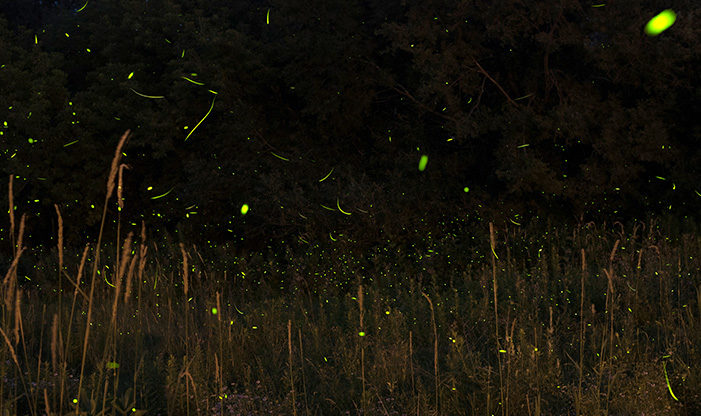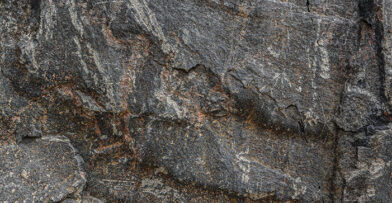Every summer, fireflies illuminate the evening sky with an irresistible light show. But there is much more to their life-cycle than this display reveals. Fireflies are complex creatures with longer lives and a more varied existence than you might think. Knowledge about these illustrious insects is always changing.
Fireflies are a part of the beetle family (Lampyridae), in the order Coleoptera. Information about this species is in constant flux, but it is believed that there are 2000 firefly species worldwide, with up to 200 species in North America and 17 species flashing throughout Milwaukee. At Schlitz Audubon, 10 species of firefly within three genera have been documented.
A Unique Characteristic of Fireflies
Fireflies are known for a unique physical trait called bioluminescence, which is defined as the production and emission of light by a living organism. It occurs widely in marine vertebrates and invertebrates, some microorganisms, and terrestrial arthropods such as fireflies. In fireflies, the emission of light is seen in the flash patterns emanating from the lower abdomen. These light patterns have several uses and allow the identification of individual species by other fireflies, as well as by people.
People can identify a species by the flashing light’s speed, color, and intensity, along with the time of day it is seen. The light, which appears as white, yellow, and amber, with some instances of green and orange, is created by the chemical luciferin when the enzyme luciferase reacts with oxygen in cells called photocytes. Because the light is made solely by this chemical reaction, there is no heat emitted. Thus, it is called cold light. In contrast, incandescent lightbulbs produce 10 percent light and 90 percent heat.
It takes time and patience to learn how to identify fireflies. But each species has a definitive flash pattern that you can learn to spot, including members of the genus Photinus, which includes a species with the signature name Big Dipper (Photinus pyralis). When flying, they drop and then rise in a J-shaped pattern that looks like the star pattern called the Big Dipper.
Reproductive Strategies of Fireflies
The purpose of bioluminescence in many organisms is defense, but in fireflies it’s also used for mating purposes. When fireflies are mating, males fly higher up in the air and flash while females stay on the ground. Males with the brightest flash are considered the strongest and most attractive to females. When a female firefly is interested in mating, she emits a flash in response, and the male will then descend toward her.
During the mating process, males of most firefly species deliver what is known as a nuptial gift, which contains spermatozoa and a host of helpful proteins. Males with the strongest, brightest flash are considered to possess the best and biggest nuptial gifts. Studies at Tufts University have found that there are more than 200 proteins within this gift, including enzymes to help females lay eggs, proteins to enhance male sperm, and the substance lucibufagin, which is a bitter tasting toxin that helps protect eggs and adults from predation, along with other proteins. Overall, the gift strengthens reproductive success and helps produce the healthiest eggs.
The Firefly Life-cycle
There are four stages in a firefly’s life-cycle. The egg phase requires moist soil for it to be successful, and the eggs are either found in the soil, moss, or in leaf litter. The eggs are deposited in mid-summer, hatching within three to four weeks. Fireflies then enter the larval stage, which lasts for up to two years. During the larval stage, a firefly’s main activity is eating, mostly at night. Firefly larvae thrive in rotting wood and forest litter, and are found in fields, forests, and marshes. The larvae feed until fall, molting to shed their exoskeleton as they grow, replacing it with a larger cuticle until it reaches up to 3/4 of an inch in diameter. After spending up to their first two years as larvae, they will burrow under the soil at varying times to pupate in winter.
Later in the spring, they metamorphosize using a process called histolysis. This process breaks the pupa’s body down, activating the formation of special cells called histoblasts. These cells trigger biochemical reactions that transform the pupa into an adult after about two weeks. The pupa then emerges as an adult, which is consumed by the motivation to mate. During the adult stage fireflies usually don’t eat, and some don’t even possess mouthparts to do so. Adults live a frenzied existence for about two weeks, until they produce eggs and complete their life-cycle.
Value & Variety of Firefly Behavior
These creatures are valuable to the ecosystem as well as home gardens. Fireflies eat garden pests while in the larval stage, voraciously consuming as much food as they can, including slugs, snails, worms, and other insects. As adults, they are also sometimes considered pollinators, which are beneficial to native plants.
Fireflies are not preyed upon by many animals. This is because of the toxic chemical lucibufagin, which makes the firefly poisonous and ill-tasting to most of their would-be predators. Spiders and other invertebrates will eat them, however.
Despite their namesake, not all fireflies light up. Many species that live east of the Rocky Mountains flash, while most western fireflies are dark. Another interesting variation on the use of flashing is the case of the femme fatale, which is a female firefly in the genus Photuris. She will flash in a pattern of a member of the genus Photinus. When the male of that genus approaches, instead of mating, he is eaten. This happens because the female Photuris lacks the ability to produce lucibufagin to defend her eggs, and she will obtain it when she eats the male firefly.
Conservation Status of Fireflies
The population of fireflies has declined in recent years. Many species, other than those that are crepuscular and prefer twilight times, are affected by light pollution, which undermines their communication and mating behavior. As light from developed areas has replaced the dark forest and fields where fireflies were once abundant, their signaling flash patterns have been disrupted. This leads to fewer larvae being produced.
Another threat is habitat destruction, which includes development, but also includes mowing lawns too short for fireflies to shelter in and pesticide use. Longer grasses provide shelter and hiding places for these natural pest controllers. To help maintain a healthy population of fireflies, consider keeping lawns longer and leaving some leaf litter on the ground.
The fascination of firefly displays can also motivate people to make them into a tourist attraction. There is evidence that areas in forests and marshes where too much human traffic has been generated, with its accompanying use of cell phones, car lights, and other light-emitting devices, now have reduced firefly populations.
Watching Fireflies in Action
If you are interested in helping fireflies, there are Citizen Science programs in which people can monitor their status. The Firefly Watch Community Science Project from Mass Audubon is designed for people across North America who want to monitor fireflies from their own home during the summer months. Information on firefly populations is sparse, so any assistance is helpful. Anyone who can spare a few minutes a week can join this program. Getting involved is a good way to help threatened firefly populations by helping scientists gather important data.
If you would like to see the lights of fireflies this summer, look out over open spaces or your yard between late June and early September. They appear at varying times of night depending on the species but are usually spotted at dusk and later. If you are at the Center for one of our late-evening programs, there are many fireflies to see on the Terrace Loop and in the West Meadows. On Wednesday, July 24 join us for Fireflies: Nature’s Fireworks, where you will learn how to identify common species by their flash patterns and see them up close.
With Contributions from: Aubrey Ellickson Fulsaas, Emily Leonard, & Moya Mowbray


